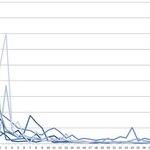Technology

Taking Andy Warhol's quip, "In the future, everyone will be world-famous for fifteen minutes," (which seems, like so many quotations, to have been stolen or mis-attributed) as a point of departure, Albert-Laszlo Barabasi hypothesized that perhaps the internet was the place where this prediction might be close to accurate.
In his 2010 book "Bursts," Barabasi looks at many phenomena related to dispersion, starting with Einstein's thought experiments and predictions for a power law to describe the "random" movement of dust particles in water.
Einstein's original observations (in his mind -…

With all of the recent controversy about claims that Monsanto funding a plant biologist skewed discussion by scientists in their favor, and claims that organic PR companies strategically used anti-science activists at Mother Jones and the New York Times to keep those readers against GMOs, a public relations study couldn't be more timely.
The Federal Trade Commission revised product endorsement guidelines to cover online media in 2009. Since then, the commission requires blogs and social media outlets to disclose any compensation they might have received for online reviews and endorsements.…

Twelve years ago, the inventors of the process that would lead to Fairlife milk engineered a process to "separate milk into its five key components – water, butterfat, protein, vitamins and minerals, and lactose."
By then recombining the components, they not only removed the lactose, making it digestible with less drama for lactose-intolerant people, but also giving it 50 percent less sugar, 50 percent more protein and 30 percent more calcium.
That's a huge breakthrough. How has the blogging community reacted?
They're calling it the Frankenstein of Milk, which tells us all two important…

Despite billions of dollars in outreach programs designed to lure women into computer programming, and companies mandating that more women be hired, most females would rather go into something involving people.
Yet a new survey of 270 high school students concludes that three times as many girls would interested in enrolling in a computer science class if the classroom was redesigned to be less "geeky" and more inviting.
So we can knock Barbie dolls and pink clothes, but they are appealing to the market that is rather than the market some academics would like it to be. The notion that women…

When we talk about artificial intelligence (AI) – which we have done lot recently, including my outline on The Conversation of liability and regulation issues – what do we actually mean?
AI experts and philosophers are beavering away on the issue. But having a usable definition of AI – and soon – is vital for regulation and governance because laws and policies simply will not operate without one.
This definition problem crops up in all regulatory contexts, from ensuring truthful use of the term “AI” in product advertising right through to establishing how next-generation automated weapons…

Behind the success of the new wave of location based mobile apps taking hold around the world is digital mapping.
Location data is core to popular ride-sharing services such as Uber and Lyft, but also to companies such as Amazon or Domino’s Pizza, which are testing drones for faster deliveries.
Last year, German delivery firm DHL launched its first “parcelcopter” to send medication to the island of Juist in the Northern Sea. In the humanitarian domain, drones are also being tested for disaster relief operations.
Better maps can help app-led companies gain a competitive edge, but it’s hard…

Forget the Turing and Lovelace tests on artificial intelligence: I want to see a robot pass the Frampton Test.
Let me explain why rock legend Peter Frampton enters the debate on AI.
For many centuries, much thought was given to what distinguishes humans from animals. These days thoughts turn to what distinguishes humans from machines.
The British code breaker and computing pioneer, Alan Turing, proposed “the imitation game” (also known as the Turing test) as a way to evaluate whether a machine can do something we humans love to do: have a good conversation.
If a human judge cannot…

A new device transforms paralysis victims’ breath into words.
Billed as a tool to help bring back the art of conversation for sufferers of severe paralysis and loss of speech, the prototype analyses changes in breathing patterns and converts ‘breath signals’ into words using pattern recognition software and an analogue-to-digital converter. A speech synthesizer then reads the words aloud.
The Augmentative and Alternate Communication (AAC) device is designed for patients with complete or partial loss of voluntary muscle control who don’t have the ability to make purposeful movements such as…

Tomato lovers rejoice: Adding or rearranging a few simple steps in commercial processing could dramatically improve the flavor of this popular fruit sold in the grocery store, according to researchers.
"Ideally, tomatoes should be picked ripe and then sold immediately, as they are at farm stands," says Jinhe Bai, Ph.D. But this isn't always possible for commercially sold tomatoes, which are often stored and then shipped over long distances.
To prevent tomatoes from becoming too ripe before they reach the store, growers pick them when they are still green. Packers then use a gas called…

Scientists working have developed a brain-computer control interface for a lower limb exoskeleton by decoding specific signals from within the user's brain using an electroencephalogram (EEG) cap.
The system allows users to move forwards, turn left and right, sit and stand simply by staring at one of five flickering light emitting diodes (LEDs), according to the paper in the Journal of Neural Engineering.
Each of the five LEDs flickers at a different frequency, and when the user focusses their attention on a specific LED this frequency is reflected within the EEG readout. This signal is…